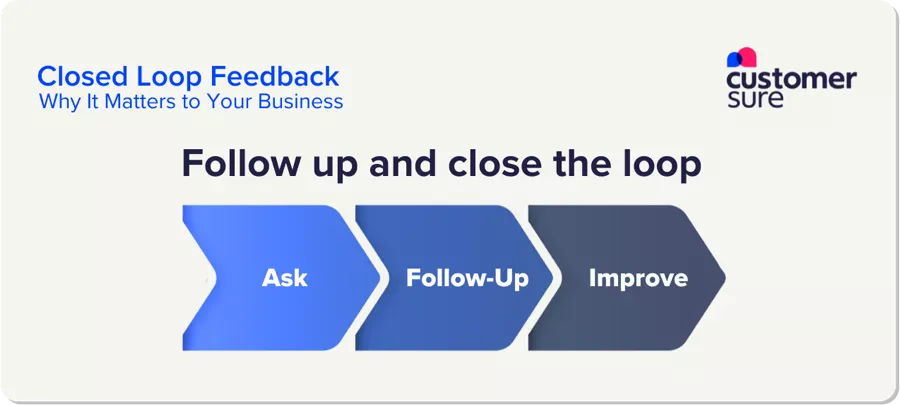In this Guide…
Collecting feedback isn’t enough. The real ROI comes when you close the loop — respond, fix issues, and show customers you listened. Here’s why it matters and how to make it part of your CX routine.
Ever asked for feedback but never replied to it?
You’re not alone. And your customers notice.
Think about it: when someone takes the time to tell you what’s going wrong (or right), the worst thing you can do is… nothing. That silence can do more damage than the problem they mentioned. It’s the digital equivalent of being ignored in a face-to-face conversation.
That’s why closed loop feedback matters. It’s about more than just collecting responses. It’s about making sure the right people see them, act on them, and, crucially, respond to improve the customer’s satisfaction rather than just measure it.
In this blog post, we’ll break down:
- What closed loop feedback really means
- Why it’s essential if CX is to deliver a return on investment
- A step-by-step guide to doing it well
- Best practices we’ve learned from working with hundreds of teams
- And how CustomerSure makes it easy
What Is Closed Loop Feedback?
Closed loop feedback means following up with customers after they’ve shared their feedback, in a way they might reasonably expect you to. Simple, right?
You’ve probably seen it happen badly:
- A customer gives feedback through a post-service survey.
- The CX team analyses the response along with all the other feedback received and produces an insightful report.
- Nobody contacts the customer about their individual issue…
- A customer is lost — avoidably. Your revenue and reputation take a hit.
The system appears to be highlighting issues successfully, you may even be putting plans in place to fix the issues, but from that customer’s point of view? Silence. No acknowledgement, no solution, no loyalty-building moment.
Closing the loop is about completing the cycle. You acknowledge their feedback, take action, and let them know what’s changed that’ll stop it from happening again.
It’s one of the core principles we cover in our Three Foundations of Voice of the Customer guide. You have to listen at the right time, make it easy, and, most importantly, follow up.
Why Closed Loop Feedback Matters for CX
Closed loop feedback is more than a nice-to-have. It has a tangible business impact:
- Improves retention: A study by the Harvard Business Review showed that simply following up on complaints can increase customer retention and satisfaction levels by up to 50% (source).
- Reduces churn: 59% of customers will leave after a single bad experience (source), and failing to respond to feedback is often one of them.
- Builds trust: When customers see that their feedback is valued, they’re more likely to stick around, spend more, and advocate for your brand.
- Drives a customer-focused culture: Closing the loop empowers every team, not just Customer Experience (CX), to make customer-driven decisions. It’s how you go from listening to transforming.
Want a deeper dive on why retention matters so much? Check out Why Customer Retention is the Key to Sustainable Growth.
How to Implement Closed Loop Feedback
Here’s how to put it into action:
1. Collect and route feedback
Make sure you’re asking for feedback at the right moments (post-interaction, post-purchase, etc.), and that it’s going to the right people. If your journey maps aren’t in order, you’ll struggle to do this.
Here’s how to choose the right customer feedback software to help.
2. Understand the context
Before replying, take a second to understand who the customer is, what their history is with you, and what really matters to them.
3. Respond quickly, and personally
Speed matters. So does tone. Don’t send a bland, templated “thank you for your feedback” email. Show them you listened.
If you’ve ever wondered why it’s so hard for companies to respond well, we wrote about it here.
4. Follow up and close the loop
This is the magic step.
Is it a problem with a business process? Thank the customer for pointing it out and tell them what you’re going to do.
Is it just a problem for that one customer? Fix it in a way that makes them happy.
It’s super simple if you set your mind to it; it means you keep that customer’s business, which is valuable in itself, and it also strengthens your reputation, which makes it easier to attract new customers.

If you’re already doing this – great! But are you tracking how often you actually close the loop?
Best Practices for Closing the Loop
Here’s what separates the average from the excellent:
- Prioritise urgent or negative feedback Fixing what’s broken should come first. You’ll reduce churn and frustration straight away.
- Don’t ignore the positives Praise is a powerful connector. Following up with happy customers builds loyalty too. Here’s why you should learn from your happy customers as well.
- Track closure rates It’s not enough to collect feedback. Track how often you reply and resolve it. CustomerSure’s feedback status system makes this easy.
- Empower your teams Don’t trap feedback in the CX team. Give product, ops, and frontline staff access so they can act too.
- Report the impact on revenue & profit. How many customer losses have been avoided by prompt interventions? What high-impact business weaknesses have been identified and fixed? Has there been an increase in new customers via word-of-mouth referrals.
Closing the Loop with CustomerSure
This is where we can help.
CustomerSure is built to make feedback meaningful, not just collected and forgotten. With our platform, you can:
- Route feedback to the right person in real time
- Track whether replies are sent and issues are resolved
- Automate follow-ups to close the loop with customers
- Share insights across teams so everyone stays in the know
Want to see how it works? Book a discovery call with us. We’ll show you how you can close the loop faster and easier.
Final Thought: Are You Really Closing the Loop?
It’s easy to think you’re listening to customers. But unless you’re acting on what they say, and telling them you did, the loop isn’t closed.
We all know how bad it is to deal with a company that doesn’t care. If you’ve ever said, “We want to be more customer-centric,” this is where it starts. Not with a new campaign. Not with a shiny tool. With a reply. A fix. A follow-up.
Are you ready to start?
Need help closing the loop with your customers? Let’s chat.
Is your VoC programme delivering measurable results?
Gain a clear view of how mature your VoC programme is, and receive tailored recommendations to take it to the next level.
Take the assessment »